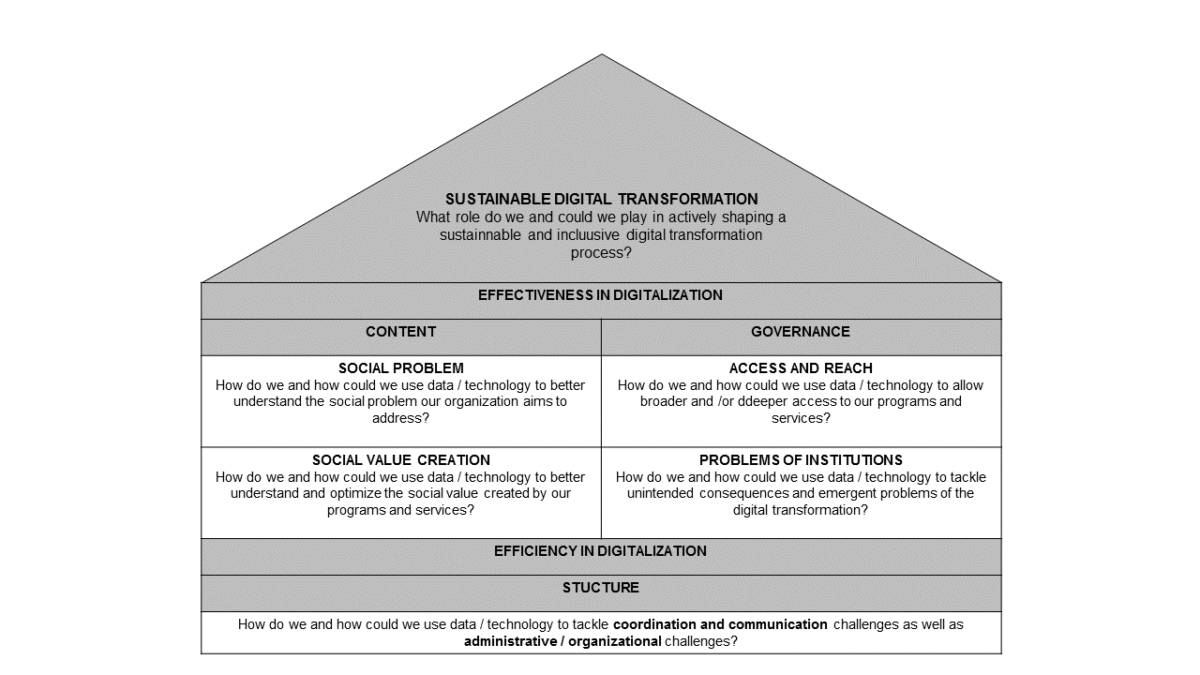Unsere vernetzte Welt verstehen

Digitale soziale Innovation: von Effizienz zu Effektivität in der Digitalisierung
Wie kann Technologie Organisationen helfen, gesellschaftliche Herausforderungen effektiver anzugehen? In diesem Artikel stellen wir das Konzept der „effectiveness in digitalization“ vor, das ein wichtiger Teil bei allen Digitalisierungsbemühungen in NPO ist und zu einer inklusiven und nachhaltigeren digitalen Transformation beitragen kann.
How can technology help organisations to more effectively tackle societal challenges? Not least in times of Covid-19 thinking about how societal challenges can be met with the support of technology has become a ever more relevant question. Recently, we are granting more and more attention to the question how organisational efforts help tackle multidimensional, complex, and interlinked societal challenges . While there is still much to learn in answering this question, we know even less about the role technology plays or may play in these efforts. Looking at existing studies on digitalisation of NPO, we find that the focus is frequently put on what we call efficiency in digitalisation: how NPO can use technology to function in the best possible manner with the least waste of time and effort. Yet, few studies look into effectiveness in digitalisation: how NPO can use technology to more successfully tackle societal challenges. In this article we introduce the concept of effectiveness in digitalisation, which, we believe, is key to any digitalisation effort in NPO and also likely to contribute to a more inclusive and sustainable digital transformation.
What we know about digitalisation in organisations tackling societal challenges
Existing studies on nonprofit digitalisation find that only 11% of nonprofit organisations view their approaches to digital as highly effective. 58% of charities don’t have a defined digital strategy or consider digital to be embedded in their strategy. Organisations that do use technology use it to manage client and volunteer data, for administrative tasks and for improving internal processes. And while 76 per cent of NPOs claim to know indicators to measure their impact, only 46 per cent of organisations report on them at least once a year and 39 per cent of the organisations do not collect, analyse or report data that helps them understand their social impact. 60% of nonprofit organisations do not use data at all to make decisions within the organisation .In turn, 70% of nonprofit organisations think that digitalisation will become relevant for them in the next years in order to enable more efficiency in administrative tasks.
Those studies show not only that there is still much to do when it comes to nonprofit digitalisation but also that if technology and data is used in organisations pursuing social goals it is mainly used in improving and/or optimising support processes. Yet, we have a very limited picture of how technology and data is used in in the actual core of their activities: creating social value.
Business model approaches and organisations tackling societal challenges
In the for-profit domain, changes in the way organisations create value are often explored through a business model lens. In this context, a vast body of literature has evolved around digital business model innovation and the question how organisations can change or adapt the way they create value in the context of digital transformation. For organisations tackling societal challenges, value creation is different: the main objective is to tackle a social problem and creating value for wider society and/or the environment. Less focus is set on appropriating large amounts of the value created for private gains.
Zott and Amit (2010) define an “activity in a focal firm’s business model… as the engagement of human, physical, and/or capital resources of any party to the business model (…) to serve a specific purpose toward the fulfilment of the overall objective”. They propose three design elements of business models: content, structure, and governance. Taking this framework to think about the management problems that emerge in non-profit organisations, we find that most digitalisation efforts in nonprofit organisations focus on the structure dimension: on solving coordination and communication challenges as well as administrative challenges that are related with organisational efficiency – functioning in the best possible manner with the least waste of time and effort. Less focus, however, is set on the content and governance dimensions that are, in turn, more related to organisational effectiveness – how organisations pursuing social goals can use technology to more successfully tackle societal challenges.
Effectiveness in digitalisation: opening up the content dimension
The content dimension relates to the question what activities should be performed to tackle social problems: to dimensions and root causes of social problems as well as to weather and how programs and services successfully tackle social problems.
What are the dimensions and root causes for social problems? How are they embedded in the social fabric? One of the major challenges in tackling social problems is the question if we have an appropriate understanding of the social problem and if the approaches to tackle them are appropriate and effective. Societal challenges such as inequality are highly complex, multidimensional and interlinked problems. The deeply nested and relational nature of the problems poses challenges for purposeful organisational action to overcome it. Better understanding the problems tackled as well as the effects of organisational activities on the problems is likely to foster deeper and broader social value creation. For instance, Understand Homelessness uses data to better understand the homelessness issue in the united states through visualisation and communication techniques and provide inspiration and solutions for city officials, organisations, and citizens to approach this challenge. Other projects aim to better understand problems like inequality in education or access to social services and unemployment.
Evidence on whether and programs and services offered by organisations alter for instance patterns of exclusion or prevent powerful elites from capturing program benefits is still hard to find. As stated above, while 79% of non profit organisations consider social impact to be their central measure of success, 39 per cent of the organisations do not collect, analyse or report data that helps them understand their social impact. Additionally, impact measurement is more frequently conducted to prove success to funders rather than to improve programs or services organisations are offering and generating an internal understanding of the value their services and programs create for their beneficiaries and society. However, data and technology can help to understand what does work and what not work in addressing societal through scientific research but also through capturing data within organisations and programs. Technology can for instance support NPOs in collecting feedback from their beneficiaries about how they use their services and the long-term effects programs and services generate on their lives.
Effectiveness in digitalisation: opening up the governance dimension
The governance dimension relates to the question when and by whom activities should be performed. It relates to questions of access and reach as well as to problems of institutions or unintended consequences
While activities of organisations pursuing social goals were long focused on local level, technology is likely to allow organisations to access a larger number of beneficiaries or extend services and programs offered to generate deeper social value. Better needs recognition may help generate more appropriate services and programs, products and services adaptation may take place at a faster pace, or technology may allow further away beneficiaries to access services and programs offered. For instance, accessibility options built into websites or online counseling may allow a border number of people to access programs and services also from remote places.
Particularly in the context of digital transformation existing problems of institutions may change and new ones may open up. Sticking with the example of inequality, new forms of inequality may develop as ownership of, access to and capabilities to deal with technologies and data are distributed unevenly across society. Actors and policies may not be aware of those changes and there may be a lack of mechanisms able and appropriate to tackle those problems. Particularly social entrepreneurs may emerge as actors who solve newly emerging or changed problem spaces and with this tackle emerging unintended consequences or externalities of the digital transformation. Those include for instance organisations tackling hate speech online, initiatives to address online disinformation or approaches using AI to tackle sexual abuse online.
So what? The digital effectiveness canvas
While the efficiency approach to digitalisation is frequently applied in for-profit organisations and meets their focus on maximising financial returns, we believe that this approach is not equally valuable to nonprofit organisations that (besides being efficient) aim to maximise the social value they create and successfully tackle societal challenges. Thus digitalisation strategies should not simply be transferred from the for-profit to the non-profit sector but the nonprofit sector should rather find own approaches that meet the specific and more complex needs of this type of organisations. Figure 1 shows the digital effectiveness canvas. While digital efficiency provides the basis for digitalisation in organisations pursuing social goals and is mainly concerned with aspects of organisaitonal structure, effectiveness in digitalisation is concerned with questions of content and governance. Thinking about effectiveness in their digitalisation efforts will allow NPOs to not only develop their own approach to digitalisation but also to shape a sustainable and more inclusive digital transformation that contributes to better tackling stubborn societal challenges and create value for groups in society that are not catered to by markets and politics.

Dieser Beitrag spiegelt die Meinung der Autorinnen und Autoren und weder notwendigerweise noch ausschließlich die Meinung des Institutes wider. Für mehr Informationen zu den Inhalten dieser Beiträge und den assoziierten Forschungsprojekten kontaktieren Sie bitte info@hiig.de

Jetzt anmelden und die neuesten Blogartikel einmal im Monat per Newsletter erhalten.
Digitalisierung und Nachhaltigkeit
Raus aus dem Digitalisierungsstau: Data Governance bringt Städte und Gemeinden auf die digitale Überholspur
Der Data Governance Wegweiser unterstützt Verwaltungen, digitale Lösungen effektiv umzusetzen.
Netzecho: Reaktionen auf die Tagesschau in Einfacher Sprache
Seit 2024 gibt es die Tagesschau in Einfacher Sprache. Wie wird das neue Nachrichtenformat von Nutzer*innen im Internet diskutiert?
Chancen gegen Einsamkeit: Wie Pflegeeinrichtungen das Quartier vernetzen
Was hilft gegen Einsamkeit im Alter? Pflegeeinrichtungen schaffen neue Räume für Gemeinschaft und digitale Teilhabe.




